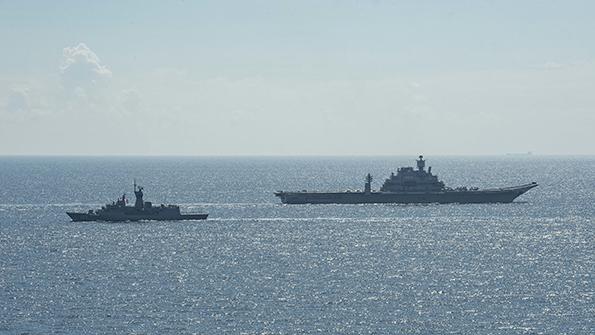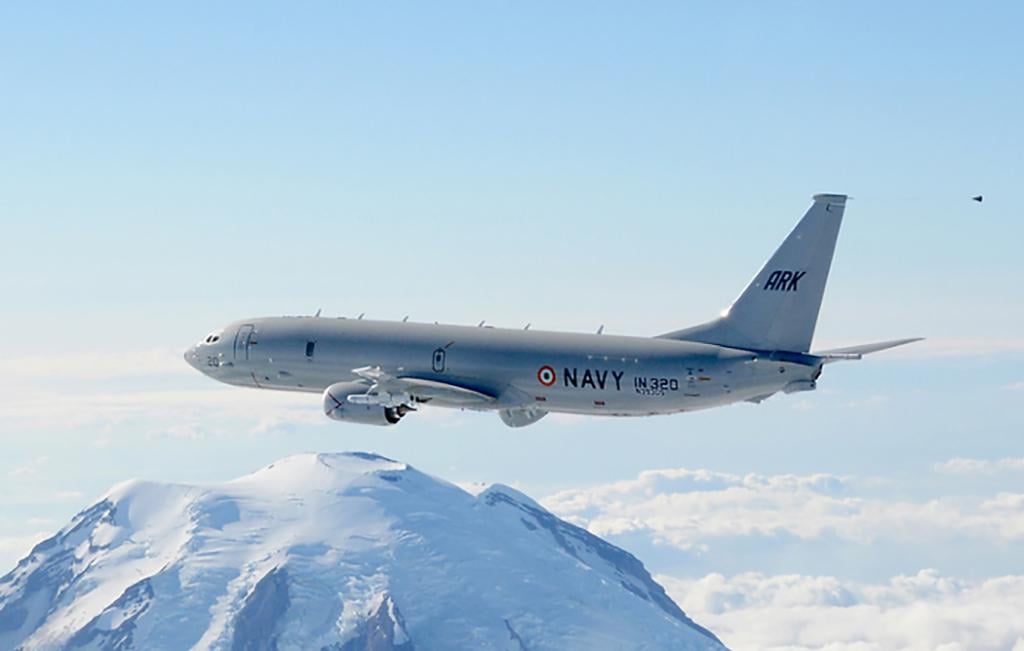How India May Rely On Its Navy To Offset China

An Indian confrontation with the Chinese People’s Liberation Army (PLA) in the eastern Ladakh region could result in Indian naval acquisitions driving the growth of a domestic military aviation industry this decade.
- India is considering the purchase of a third aircraft carrier
- Navy officials are leaning toward western aircraft in order to remain interoperable with allies in the Pacific
PLA incursions into the Ladakh region in early 2020 and a deadly skirmish at Galwan Valley spurred a volley of missile tests and prompted India to invite a fourth partner to Exercise Malabar—the Royal Australian Navy—to join Japan and the U.S. The nation’s focus on naval alliances coincides with a renewed debate in New Delhi about long-term defense expenditures, a conversation in which the navy has long received the smallest share of the budget.
A large part of the discussion concerns assets the Indian Navy should pursue—specifically, a third aircraft carrier and its associated aircraft. Naval aviation capabilities are key for India to dominate the Indian Ocean region along with its Quad (Quadrilateral Security Dialogue) partners: Australia, Japan and the U.S.
While any increase in Indian naval strength might be perceived as a move to become the region’s gatekeeper, as a “net security provider,” navy chief Adm. Karambir Singh sees the service’s role instead as a “preferred security partner.”
Regional security, including that of sea lines of communication, remains an important objective for the Indian Navy but is now more important than ever. India sees as imperative the need to offset the PLA across the Himalayas by controlling access to sea lanes across the Indian Ocean, from the Straits of Malacca to Hormuz and the Gulf of Aden. Since no navy can accomplish this on its own, India may opt to acquire platforms that offer a high level of interoperability with allies.
Wish List
The Indian Navy intends to have a fleet of 445 aircraft by 2030, with a number of acquisitions already planned: 57 fighters, 111 utility helicopters, 123 multirole helicopters and 24 Sikorsky MH-60R helicopters are on order. The list also includes additional Boeing OP-8I long-range maritime reconnaissance aircraft. The navy had an original requirement for 31 of the aircraft, of which nine are in service. Three more have been ordered, and a further six are expected to be ordered, though the service also has an increasing interest in unmanned platforms after the recent lease of two General Atomics MQ-9B UAVs.
Plans to purchase a new, third aircraft carrier are just one piece of that naval aviation expansion. The navy had already been contemplating spending about $25 billion long before the eastern Ladakh crisis transformed earlier assumptions. The service has plans to build a twin-engine deck-based fighter (TEDBF) to enter service in the early 2030s.
The third aircraft carrier, a 65,000-ton catapult-assisted-takeoff, barrier-arrested-recovery (Catobar) flat-deck (priced at $6.15 billion), which envisages the launch of fixed-wing reconnaissance aircraft in addition to fighters, is the only one of the lot that has yet to be approved. The battle within the defense ministry over the purchase of a third aircraft carrier is likely to be fought over the next year or two.

Maritime Pivot
It is no secret that Indian defense acquisitions have lagged on both money and time. But even amid the COVID-19 pandemic, the new decade signals prioritization for an area traditionally lower on the list for the nation’s land-focused defense planners.
Adm. (ret.) Arun Prakash, former navy chief and the chair at India’s Naval War College, says some of these contingencies have already been contemplated by the navy in prior planning. “But these plans were made in a strategic vacuum, at the national level, at the time. It is ironic that for the first time the importance of the maritime domain has been driven home to decision-makers because of the confrontation in the Himalayas,” he says. “The ‘hardware versus strategy’ conundrum, where we have been thinking about strategy only after acquiring hardware, is a process that needs to be reversed.”
Vice Adm. (ret.) Shekhar Sinha, former head of India’s Western Naval Command, sees a growing realization of the importance of India’s naval capabilities. “India has traditionally had a continental mindset and thought of defense in terms of land-centric warfare. This is an inherently defensive strategy leaving few options when the [PLA] invades your territory,” he says. “This is why people are now beginning to understand the options naval power offers India for defending its northern borders.”
The Pentagon’s 2020 annual report to Congress on Chinese military power notes: “The [People’s Republic of China] has the largest navy in the world, with an overall battle force of approximately 350 ships and submarines, including over 130 major surface combatants.” The report adds that China is the top producer of ships by tonnage and is increasing its shipbuilding prowess in all classes. Meanwhile, as of early 2020, the U.S. Navy’s battle force was approximately 293 ships.
“The third carrier and naval aviation will be essential for the time when the Chinese begin to assert themselves in the Indian Ocean region,” Sinha says.
Australia, Japan and the U.S. all announced plans in 2020 for significant expenditures to counter Chinese military capabilities in the Indo-Pacific region.
Prakash puts the acquisition plans in perspective. “Although these seem like large acquisition plans, in reality many of these are filling long-standing voids in capability and not enhancing it,” he says. “But a third aircraft carrier and the planned 57 new fighters are what will constitute a substantive accretion.”
Singh told news media in December that the navy intends to make its case for the third aircraft carrier to the government, pending responses to outstanding requests for information. “As a navy, we are absolutely clear of the utility of the third aircraft carrier, because air operations are absolutely integral to naval operations—air power at sea is absolutely required. And it is required here and now, that kind of air power,” he said.
Industry Boost
Still, these programs represent a capability-focused strategy, driving acquisition planning with the objective of boosting domestic industry commensurate to the size of the market.
“Both the naval helicopter programs are strategic partnership programs. That means most of them have to be built in India,” Sinha says. “The third aircraft carrier would be built here, as well. Add on the TEDBF development program, and all this taken together offers a lot of scope not only as a market but, more importantly, to jump-start industry in India.”
Strategic Partnership programs under Chapter 7 of India’s Defense Acquisitions Procedure mandate that the prime be an Indian company, requiring collaborations with foreign OEMs. The declared objective of the model is “to enable participation of private Indian firms in Make in India in defense.”
Prakash sees scope for industry in building the capability required by the navy. “This crisis can represent an opportunity in the coming decade and beyond for providing India with viable options and for boosting industry here,” he says. But he also offers a caveat: “There needs to be clarity about our objectives in terms of the ends we want to achieve: Decide what we need and how we will pay for it, even in these straitened economic circumstances, or look to build alliances that will serve this purpose. If that means a third aircraft carrier, then find the money for it. After all, the first charge upon the state’s exchequer must be national security.”
Western Shift
Something else that stands out is that Western equipment are the likeliest choices in all these programs. The Boeing F/A-18 Super Hornet and the Dassault Rafale M are preferred over the in-service Mikoyan MiG-29K. The F/A-18 conducted ski-jump tests in August to prove operability with India’s existing short-takeoff, barrier-arrested-recovery carrier operability requirement.
“To replace the MiG-29s, we’ve taken up a case for the [57 multirole carrier-borne fighters] we are trying to do along with the Indian Air Force,” Singh said in December. The MiG-29K is not Catobar-capable, also a requirement for the Indian Navy.
Airbus has offered the AS565 Panther and the H225M for the two helicopter programs, while Sikorsky has offered the S-76 and MH-60R. A navalized version of the Russian Kamov Ka-226T is not perceived as a serious contender, in part because of the height of the aircraft due to the coaxial rotors. While the P-8I and MQ-9B are foreign products, a third carrier and the TEDBF programs would be indigenous.
These programs paint a seascape of almost exclusively Western platforms wearing the navy roundel over the Indian Ocean. This will inevitably enhance the scope of interoperability with Western navies, with which India has conducted a growing number of engagements. These include increasingly complex exercises, coordinated patrols, intelligence sharing and exchange of supplies via logistics agreements.
“There is no question that these plans, as they stand, will represent a long-overdue shift away from poorly supported Russian toward Western platforms and systems,” Prakash says. “The naval air arm is showing the way in this regard.”
Sinha adds: “This shift toward Western kit is not only about high-tech platforms, but also about partnering with democracies with a convergence of strategic interests.”





Comments
The PLAN (Chinese Navy) has less than a score of fleet replenishment ships. A voyage from South China to the Indian Ocean is about 3500 nautical miles and would take about two weeks. A return voyage is also required. The PLAN is not going to sortie in force to the Indian Ocean because it lacks the support structure to do so. There is also no tactical advantage to be gained by the PLAN in attempting to fight the Indian Navy near its home ports.
This is simply an attempt by the Navy of India to justify an increase in its budget.
So yes its extremely relevant. China can be contained via sea control and the Indian Navy is a key to that. Cut off China from the Indian Ocean and the Navy can move into South China Sea to assist the take back of that illegal attempt to control.
Equally trying to counter attack China on land is doomed to failure at best let alone the Himalayan terrain. India may be able to stop but offensive ability to deal with China is not going to happen there.
If needed a huge blow can be struck against China in the Indian ocean let alone supporting allied forces closer to China. The forward presence and bases they are establishing can die on the vine and the financial impact and losses would be huge to China.
Keep in mind China claims anything in and beyond sight and they have historic claims all over the regions (according to them) because the China Fleet once sailed in those waters.
They now claim to be a near Arctic nation. Right now they are eyeballing about half the world.